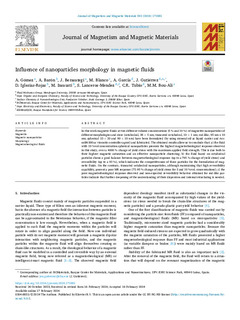Título
Influence of nanoparticles morphology in magnetic fluidsAutor-a (de otra institución)
Fecha de publicación
2024Otras instituciones
Universidad del País Vasco/Euskal Herriko Unibertsitatea (UPV/EHU)Ikerbasque
Tekniker
Basque Center for Materials, Applications and Nanostructures
Versión
Version publicadaTipo de documento
ArtículoArtículoIdioma
InglésDerechos
© 2024 The AuthorsAcceso
Acceso abiertoVersión de la editorial
https://doi.org/10.1016/j.jmmm.2024.171881Publicado en
Journal of Magnetism and Magnetic Materials Vol. 593. N. art. 171881Editorial
ElsevierPalabras clave
MagnetiteMagnetic nanoparticles
Morphology
magnetorheological fluids
Resumen
In this work magnetic fluids at two different volume concentrations (5 % and 10 %) of magnetite nanoparticles of different morphologies and sizes (octahedral, 38 ± 5 nm; truncated octahedral, 10 ± 1 n ... [+]
In this work magnetic fluids at two different volume concentrations (5 % and 10 %) of magnetite nanoparticles of different morphologies and sizes (octahedral, 38 ± 5 nm; truncated octahedral, 10 ± 1 nm; rod-like, 95 nm x 10 nm; spherical 33 ± 20 and 90 ± 10 nm) have been formulated (by using mineral oil as liquid carrier and Aerosil®300 as viscosity-controller agent) and fabricated. The obtained results allow us to conclude that: a) the fluid with 10 %vol concentration spherical nanoparticles presents the highest magnetorheological response observed in this study, over a 4000 % change of yield stress with the maximum applied field strength. This is due both to their highest magnetic saturation and an effective nanoparticle clustering; b) the fluid based on octahedral particles shows a good balance between magnetorheological response (up to a 795 % change of yield stress) and reversibility (up to a 92 %), which indicates the competitiveness of these particles for the formulation of magnetic fluids. On the contrary, truncated octahedral nanoparticles, although maintaining that high reversibility capability, present a poor MR response (75–95 % change of yield stress for 5 and 10 %vol. concentrations); c) the poor magnetorheological response observed and non-expected reversibility behavior obtained for rod-like particles indicate that further deepening of the understanding of their dispersion and internal structuring is needed. [-]
Colecciones
- Artículos - Ingeniería [761]
El ítem tiene asociados los siguientes ficheros de licencia:






















